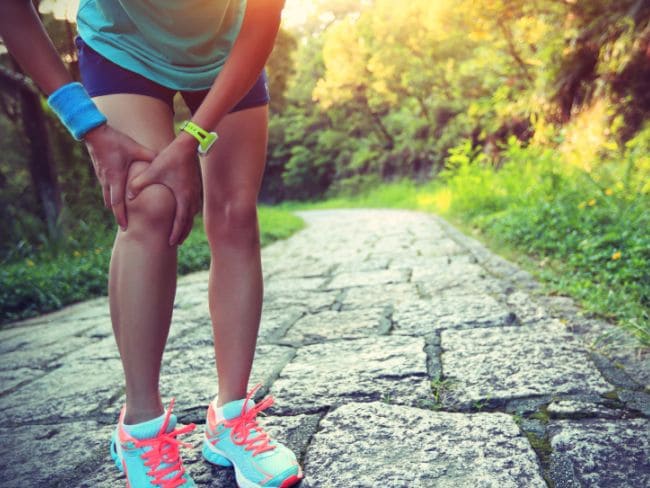Not just adults, knee pain can affect individuals at a younger age too. Read here to know from expert some possible causes and how to prevent this.

HIGHLIGHTS
- Unhealthy body weight can lead to knee pain
- Regular exercise can help you prevent knee pain
- Consume a diet rich in calcium and vitamin D for healthy bones and joints
Knee pain is a common condition that is experienced by people of all ages. Although knee and joint problems are a normal part of aging, in recent times due to unhealthy lifestyle patterns even the people at young age complain of joint pain. Many short-term and long-term problems are associated to cause knee pain.
Factors that result in Knee pain in the 20s and 30s
Knee pain has multifactorial etiologies like sports injury, obesity, female gender, knee trauma, repetitive use of joints, injury to the joint, joint laxity, low bone density, muscle weakness and genetic susceptibility all of which predispose adolescents/young adults to the development of knee problems.
1. Kneeling and squatting: Research studies suggest that kneeling and squatting for more than two hours a day is associated with a two-fold increase in causing knee disorders.
2. Obesity: Patients with metabolic syndrome or obesity may alter the articular cartilage metabolism. It has been suggested that around 27% of total hip arthroplasty and 69% of knee replacement surgery are attributed to obesity.
3. Gender: Being a female also increases the risk of knee pain and osteoarthritis by around 2 times. Evidence-based studies suggest that females have higher levels of leptin concentrations than their male counterparts predisposing them to knee pain and osteoarthritis.
4. Meniscal surgery: Patients undergoing reconstruction surgery or partial meniscectomy surgery are more likely to develop knee problems like knee osteoarthritis in the future.
5. Physical exercise: Doing physical exercise more than twice a week is also associated with an increased probability of knee pain.
Also read: Getting Back Pain Or Knee Pain In Your 20s And 30s? Follow These 10 Tips To Strengthen Your Bones
6. Vitamin D deficiency: Vitamin D deficiency can cause joint pain, and may even lead to osteoporotic problems with the bones in the future.
7. Pregnancy: Studies have suggested that women having more than 6 pregnancies are at an increased risk of knee and associated pain.
8. Patellofemoral pain syndrome: Knee pain is very common in young adults and may result due to imbalance or weakness in the muscles surrounding the kneecap, hamstring muscles being tight, problems associated with weight-bearing and alignment through the leg. Patellofemoral pain syndrome is a consequence of overuse of knee joints that puts pressure on the kneecap and cartilage within the joint.
9. Genetic Factors: Osteoarthritis associated knee pain may run in families. If anyone in the family has an osteoarthritis problem, then the young ones in the family may be at an increased risk of developing osteoarthritis and associated knee pain.
Suffering from knee pain at a young age can functionally impair and interrupt everyday activities reducing academic performance.
Also read: Turmeric For Knee Pain: Supplements Of Turmeric Show Promising Results Than Placebo, Finds New Study

Maintaining a healthy weight is crucial to avoid knee pain
Photo Credit: iStock
Do's and don'ts to avoid knee problem:
Determining the risk factors affecting your joints particularly the weight-bearing joints may reduce the risk of osteoarthritis and prevent any pain and disability arising from it. Here are a few do's and don'ts that can be followed to avoid knee problems.
1. Normal body weight: Maintaining normal body weight can prevent circulation problems and promote cartilage and bone growth thus helping avoid knee problems. On the other hand, a normal Body Mass Index (BMI) will put less pressure on the joints and may even reduce the risks of inflammation.
2. Physical exercise: Fitness exercises like walking, aerobics, and strength training exercises have proved to be effective in keeping the knee healthy, pain-free, and flexible.
3. Maintain a good posture as it helps reduce the pressure on the joints.
4. Eat leafy greens, fresh fruits like berries as they are rich in antioxidants and can prevent inflammation and pain.
5. Keep yourself hydrated as it will detoxify your blood and keep your joints healthy.
Also read: Knee Pain Management: When Is The Right Time To See A Doctor? Expert Tells
Don'ts:
1. Slouching, while sitting or standing, can strain the joints. So avoid doing that.
2. Quit smoking. Smoking can activate inflammatory pathways, making it take longer for your body to heal from injuries and worsening the pain.
3. Avoid consuming alcohol and sugary drinks.
(Dr. D K Das is a Sr. Consultant Orthopedic & Joint Replacement Surgeon at Apollo Spectra Delhi, Nehru Enclave)
Disclaimer: The opinions expressed within this article are the personal opinions of the author. NDTV is not responsible for the accuracy, completeness, suitability, or validity of any information on this article. All information is provided on an as-is basis. The information, facts or opinions appearing in the article do not reflect the views of NDTV and NDTV does not assume any responsibility or liability for the same.
DoctorNDTV is the one stop site for all your health needs providing the most credible health information, health news and tips with expert advice on healthy living, diet plans, informative videos etc. You can get the most relevant and accurate info you need about health problems like diabetes, cancer, pregnancy, HIV and AIDS, weight loss and many other lifestyle diseases. We have a panel of over 350 experts who help us develop content by giving their valuable inputs and bringing to us the latest in the world of healthcare.














